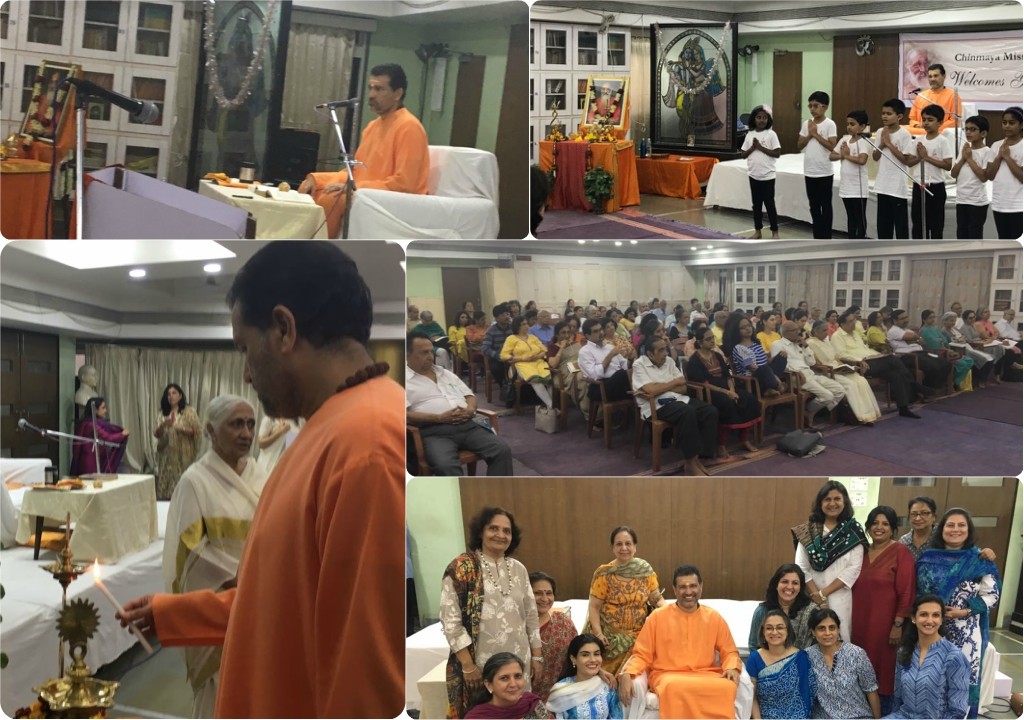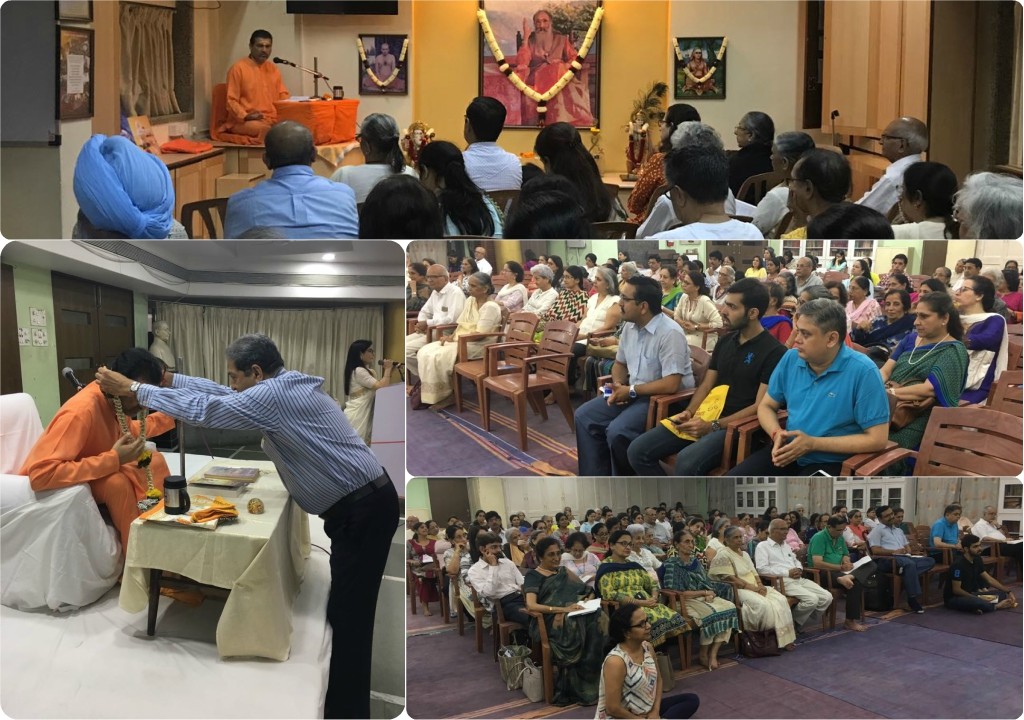A Soul Search – The Guru Answers the Scholar King
Talks based on
Ashtavakra Geeta, Chapter 1 and Meditation based on Kathopanishad, Chapter 1
South Mumbai was blessed with the presence of Swami Bodhatmananda ji from 9th to 11th August when Swamiji expounded the teachings of Sage Ashtavakra to Maharaja Janak during the evening talks and the teachings of Lord Yama to the well-prepared student, Nachiketa during the morning talks. Swamiji also visited some of the Devi/Study groups for small satsangs with lunch bhikshas.
The meditation talks were held at the center, Chinmaya Sagar in the mornings and saw a regular attendance of 30-35 attentive seekers. In talks Swamiji explained how the purpose of meditation was not just to quieten the mind to a state of thoughtlessness but to strengthen our identity that the Upanishads have declared and the weaken our identity which the world has given us. Meditation is also not for gaining new knowledge nor is it for experiencing the atma.
In order to strengthen the Upanishadic identity, we need to use the Upanishads. Swamiji emphasized that we should first do Shravanam, to listen and take in the wisdom in the Upanishads, then we should realize that the atma that is being spoken of is me. I am that infinitude. Finally, we awaken to the fact that the Upanishads are talking about me, it is my biography, my identity.
Using the mantras in Chapter 1 of Kathopanishad Swamiji explained to us how we are different from dharma-adharma, cause-effect, the 3 periods of time and that we are that Pure Consciousness – Chaitanya Swaroop. I am not matter, nor matter and consciousness, nor changing consciousness. I am that Unchanging Consciousness. I am birth less and deathless, I am akarta, abhogta and I have no sambhandha with karma or karmaphalam.
These pointers are to be used in the seat of meditation to negate the worldly identity and assert the Upanishadic identity.
The evening talks on Ashtavakra Geeta were held at Prempuri Ashram with a 150 plus very receptive audience. Swamiji pointed out that almost every shloka in the Chapter was a Mahavakya. A Mahavakya being that which reveals my infinite nature. This text has a large collection of infinitude revealing statements.
Going through the Chapter, Swamiji explained King Janak’s question of how does a seeker gain knowledge and dispassion and how is liberation attained. The only way liberation is gained is through knowledge. Vairagya and liberation are the cause for knowledge of the atma, jnanam. Jnanam will result in liberation. Vairagya and mumukshutvam cannot directly give liberation.
Swamiji explained to us what exactly is liberation – it is the giving up of what I am not and abiding in what I am. It is due to erroneous thinking that we are bound. Only knowledge can remove this false identification that we have and give us freedom. Swamiji elaborated in detail the sadhanas mentioned by Sage Ashtavakra and urged us to develop qualities like Kshama, Arjava, Daya, Tosha, Satyam. We are expected to do sadhanas till such time as we are ready to accept the Upanishadic Truths as a fact.
After the sadhanas, the nature of the atma is pointed out. The atma is other than the gross, subtle and causal bodies, the 5 elements. It is the witness of all. The atma is akarta and abhogta. I alone am satyam, rest is all mithya. Something which is mithya cannot bother that which is satyam and consequently I cannot have fear of mithya. The result of this knowledge is fearlessness.
Swamiji pointed out that there were no specific criteria to define when one is liberated. Liberation happens only when one has clear knowledge that one is free. There is no partial elimination of ignorance. Swamiji then elucidated the rest of the verses wherein different pointers of the atma have been given which may be used for meditation.
I was ever the atma. Never the meditator. Never bound. I am ever free. I am Infinitude. I am Sat Chit Ananda.
Swamiji explained the depths of Vedantic philosophy in a very simple manner, sprinkled with many humorous examples to drive home the point clearly and surely. Swamiji somehow managed to link the morning talks, afternoon satsangs and the evening talks so well, one felt that were all in continuation.
South Mumbai was left wanting to hear more from Swami Bodhatmananda ji.

